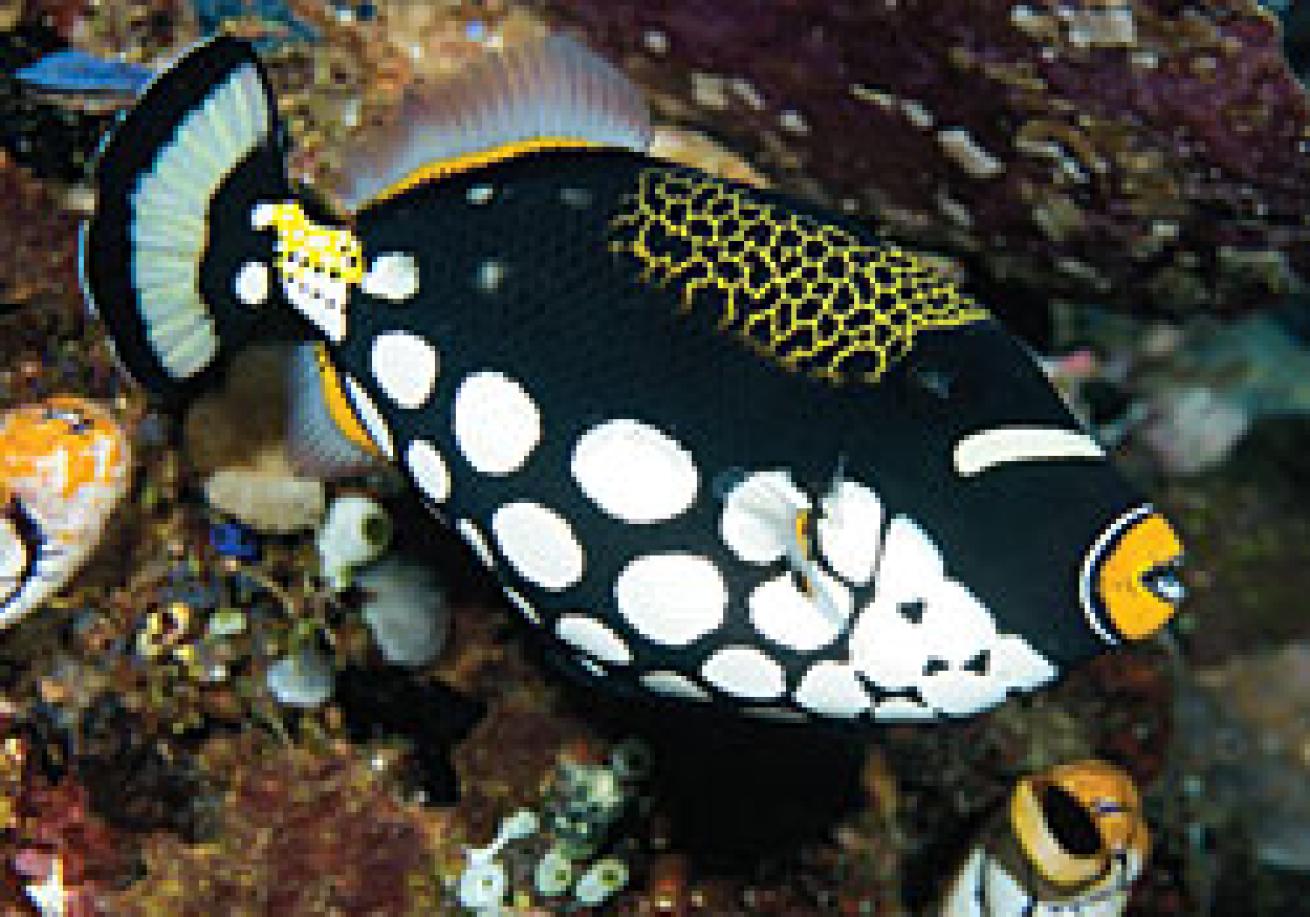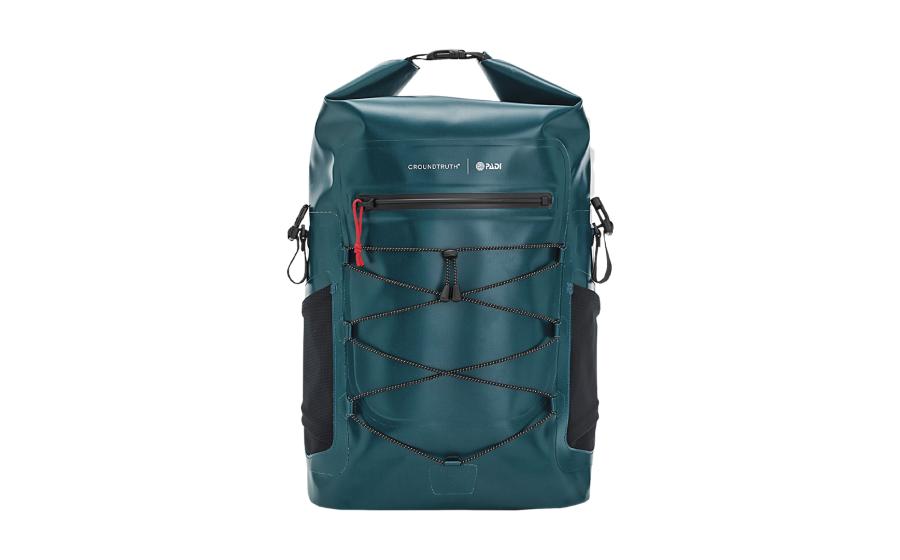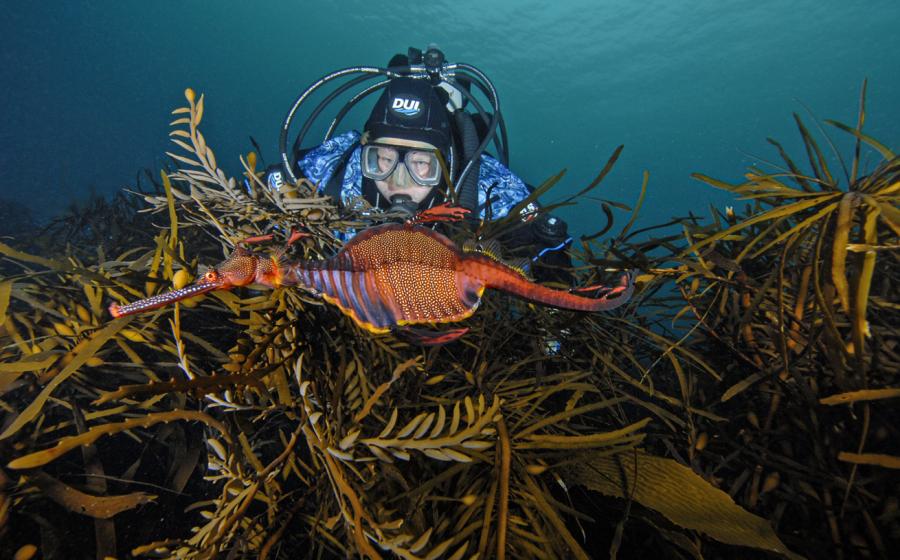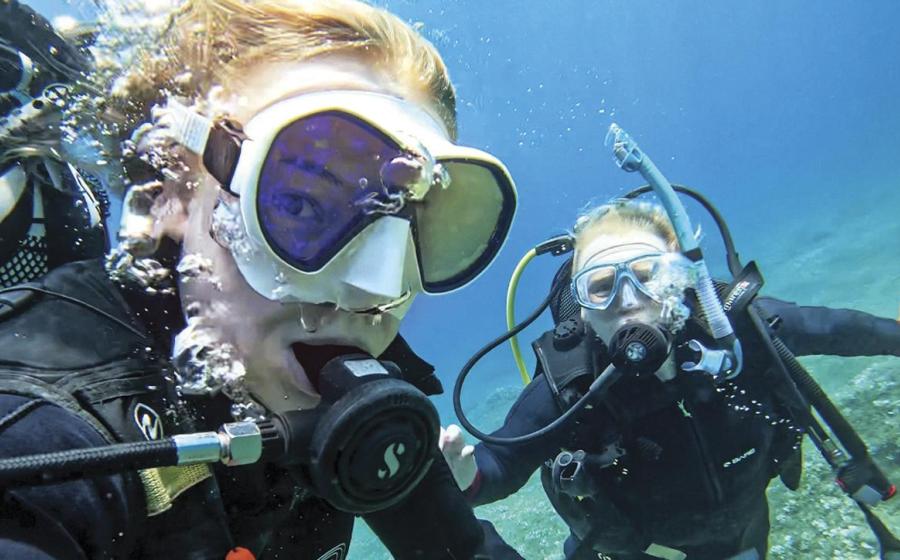Photo Etiquette in the Digital Age
March 2007
Text and Photography by Stephen Frink
One of the first articles I wrote for Scuba Diving back in the late '90s was about etiquette for underwater photographers. I wrote it after a diver sent me an e-mail complaining about how obnoxiously the photographers on her last dive trip had behaved. They monopolized the dive deck, muscled her out of the way whenever they saw something interesting underwater, and generally made her dive experience unpleasant.
Though much has changed since then, much remains the same. Back then, the Nikonos V was the dominant underwater camera, there were relatively few photographers and they were limited to just 36 shots per dive. Now, with the advent of digital technologies, there are more photographers, and they are equipped with two- to eight-gigabyte media cards able to capture more than 10 times that paltry 36 exposures. It is a good time to revisit etiquette for underwater photographers.
Space on the Dive Boat
There is no question that underwater photographers occupy more dive-deck real estate than nonshooters. In my case, there has been a net reduction in the amount of space I occupy on a dive boat. Instead of the Nikonos RS, Nikonos V and housed Nikon F100 I used back then, I now travel with a single housed Canon digital SLR that is essentially able to do all of what those three systems could do. But there are a lot more photographers now, shooting a wide variety of gear--from simple point-and-shoot cameras to unwieldy housed systems with multiple articulated arms. Clearly, there is an even greater need for organization so that we can keep out of one another's way.
Photographers need a dedicated camera table to store and work on their gear, ideally away from the direct traffic flow to the dive platform. Some day boats have one, but most don't. Even many live-aboards have camera tables that are inadequate for the quantity and size of the camera systems used by photographers today. Shooters need a dry and well-lighted place to assemble and maintain gear, as well as good camera rinse buckets dedicated to their use (which also take up space on the dive deck). Shooters should keep their gear in designated areas, and nonshooters should avoid dripping and congregating in the photographers' gear-prep zone.
Typically there is a rinse tank for cameras, and one dedicated to masks and other dive gear. These should be separate. The commercial defog agents used for masks may damage ports or O-rings, and something could bump into a fragile optic and scratch it. When multiple camera systems are placed in the rinse tank at the same time, cords entwine, and abrasive arms and trays inevitably bounce on delicate ports. Pulling one system out can entangle something else, and a flood can ensue. The goal is to displace salt water with fresh water immediately, and, to that end, a brief but thorough rinse is all that's required.
Traffic Flow to the Dive Platform
Photographers shuffling along the deck in their fins while gripping camera equipment is a recipe for disaster, or at least aggravation. Divemasters usually give directions on moving cameras to the stern of the boat. Listen and follow these directions. If it requires carrying a system from a forward camera table to a staging area at the stern, do it before putting on dive gear and fins.
Make sure strobe arms are tightly attached, and tell the boat crew how you'd like your system handed to you once you are in the water. I once watched a $1,500 mineral glass dome port smash onto the dive deck because a photographer did two things wrong: He failed to tighten the strobe arm before handing the camera back up, and he failed to instruct the crew to grip the handles instead of the system's arms. Photographers need to predict what might go wrong, and take steps to avoid it.
In-water Etiquette
Photographers should observe these simple rules of in-water etiquette:
Avoid damaging the underwater environment. Diving with a camera and strobe affects buoyancy, and viewfinder-induced tunnel vision sometimes obstructs peripheral view to the extent that a shooter can bump into coral. OK, that's why it happens, but it's not an excuse. If a diver's skills aren't up to handling a camera system underwater, he shouldn't be shooting. Unfortunately, there are also callous photographers who are consciously willing to damage the reef in pursuit of a photo. We now realize the reef is a finite resource and no one should be allowed to trash it purposely.
Use dead rock or sand patches to balance yourself. Touching coral is inexcusably wrong, but a single finger used to anchor oneself on an algae-covered rock is not a bad thing, and kneeling in sand patches is certainly reef-friendly. Be careful not to stir up a cloud of sand when you leave the bottom, thereby silting the surrounding reef.
Sensitive Interaction with Marine Life
Harassing marine life for the sake of a photo is wrong--for example, purposely puffed balloonfish or the diver-riding-sea-turtle shot. The pressures on the sea and its denizens are so intense that we have to do what we can to preserve and protect. Underwater photography is terrific for communicating the beauty of the reef, the ocean and the creatures that live there. We just have to do so in an ecologically sensitive manner.
Underwater photography has to be done at short distances. Tropical seawater is a blue-green medium 600 times denser than air, and for maximum color and resolution, photographers need to get close. And we need to use artificial light to bring back the color the seawater filters out. Yet, some marine life is very sensitive to strobe light.
"The main problem is the shock factor relative to the environmental conditions," says marine biologist and underwater photographer Dr. Alex Mustard. "So zapping creatures repeatedly at night is going to be much worse than taking pictures on a bright shallow coral reef during the day. The darker the conditions, the more the shock factor of a strobe."
As far as I know, no one has documented how many 150-watt-second flashes from six inches away it takes before a pygmy seahorse is terminally traumatized. But divemasters have learned when they take guests repeatedly to the same gorgonia where pygmies live, they need to limit the number of flash exposures in order to ensure survival of the seahorse. The reality is that when underwater photographers constantly harass some cryptic and sedentary creatures, something not very pleasant happens to them. Now that we're using cameras with far greater picture capacity, restraint and common sense is necessary.
"Ownership" of an Encounter
Simply holding a camera does not endow eminent domain over all marine life. Here are some general guidelines for sharing nicely:
Allow nonphotographers adequate time to encounter marine life. If a diver is observing something of interest, the photographer should wait from a distance, and approach once the other diver has moved on. Having a camera does not trump the dive experience of a nonphotographer.
Do not get in the way of other photographers. If you see a photographer carefully setting up a shot, do not swim nearby. Just the sound of regulator exhaust may blow the photo-op. If a photographer is taking a wide-angle shot on a vertical wall, don't swim directly beneath, as the exhaust bubbles will rise exactly where they shouldn't. Remember, the subject matter should remain that photographer's subject until he stops shooting. Bumping him out of the way or blowing impatient bubbles in the shoot zone is tacky.
Access to the wonders of the oceans is a privilege, and no one has earned precedence over another. Last month I was in a dive destination very popular for underwater photography. While making my safety stop at 15 feet, I could still see all the frenetic activity of the photographers working the shallow muck substrate below. Two of the guests from my boat were patiently exchanging access to a leaffish when a diver from another boat barged in, gave them both the evil eye and took over the subject. I could see from his camera system that this was an advanced shooter, but I did not know until we were back on the boat that he was a well-known pro. The moral of the story: If you intend to display bad behavior underwater, don't write your name on your camera.
March 2007
Text and Photography by Stephen Frink
One of the first articles I wrote for Scuba Diving back in the late '90s was about etiquette for underwater photographers. I wrote it after a diver sent me an e-mail complaining about how obnoxiously the photographers on her last dive trip had behaved. They monopolized the dive deck, muscled her out of the way whenever they saw something interesting underwater, and generally made her dive experience unpleasant.
Though much has changed since then, much remains the same. Back then, the Nikonos V was the dominant underwater camera, there were relatively few photographers and they were limited to just 36 shots per dive. Now, with the advent of digital technologies, there are more photographers, and they are equipped with two- to eight-gigabyte media cards able to capture more than 10 times that paltry 36 exposures. It is a good time to revisit etiquette for underwater photographers.
Space on the Dive Boat
There is no question that underwater photographers occupy more dive-deck real estate than nonshooters. In my case, there has been a net reduction in the amount of space I occupy on a dive boat. Instead of the Nikonos RS, Nikonos V and housed Nikon F100 I used back then, I now travel with a single housed Canon digital SLR that is essentially able to do all of what those three systems could do. But there are a lot more photographers now, shooting a wide variety of gear--from simple point-and-shoot cameras to unwieldy housed systems with multiple articulated arms. Clearly, there is an even greater need for organization so that we can keep out of one another's way.
Photographers need a dedicated camera table to store and work on their gear, ideally away from the direct traffic flow to the dive platform. Some day boats have one, but most don't. Even many live-aboards have camera tables that are inadequate for the quantity and size of the camera systems used by photographers today. Shooters need a dry and well-lighted place to assemble and maintain gear, as well as good camera rinse buckets dedicated to their use (which also take up space on the dive deck). Shooters should keep their gear in designated areas, and nonshooters should avoid dripping and congregating in the photographers' gear-prep zone.
Typically there is a rinse tank for cameras, and one dedicated to masks and other dive gear. These should be separate. The commercial defog agents used for masks may damage ports or O-rings, and something could bump into a fragile optic and scratch it. When multiple camera systems are placed in the rinse tank at the same time, cords entwine, and abrasive arms and trays inevitably bounce on delicate ports. Pulling one system out can entangle something else, and a flood can ensue. The goal is to displace salt water with fresh water immediately, and, to that end, a brief but thorough rinse is all that's required.
Traffic Flow to the Dive Platform
Photographers shuffling along the deck in their fins while gripping camera equipment is a recipe for disaster, or at least aggravation. Divemasters usually give directions on moving cameras to the stern of the boat. Listen and follow these directions. If it requires carrying a system from a forward camera table to a staging area at the stern, do it before putting on dive gear and fins.
Make sure strobe arms are tightly attached, and tell the boat crew how you'd like your system handed to you once you are in the water. I once watched a $1,500 mineral glass dome port smash onto the dive deck because a photographer did two things wrong: He failed to tighten the strobe arm before handing the camera back up, and he failed to instruct the crew to grip the handles instead of the system's arms. Photographers need to predict what might go wrong, and take steps to avoid it.
In-water Etiquette
Photographers should observe these simple rules of in-water etiquette:
Avoid damaging the underwater environment. Diving with a camera and strobe affects buoyancy, and viewfinder-induced tunnel vision sometimes obstructs peripheral view to the extent that a shooter can bump into coral. OK, that's why it happens, but it's not an excuse. If a diver's skills aren't up to handling a camera system underwater, he shouldn't be shooting. Unfortunately, there are also callous photographers who are consciously willing to damage the reef in pursuit of a photo. We now realize the reef is a finite resource and no one should be allowed to trash it purposely.
Use dead rock or sand patches to balance yourself. Touching coral is inexcusably wrong, but a single finger used to anchor oneself on an algae-covered rock is not a bad thing, and kneeling in sand patches is certainly reef-friendly. Be careful not to stir up a cloud of sand when you leave the bottom, thereby silting the surrounding reef.
Sensitive Interaction with Marine Life
Harassing marine life for the sake of a photo is wrong--for example, purposely puffed balloonfish or the diver-riding-sea-turtle shot. The pressures on the sea and its denizens are so intense that we have to do what we can to preserve and protect. Underwater photography is terrific for communicating the beauty of the reef, the ocean and the creatures that live there. We just have to do so in an ecologically sensitive manner.
Underwater photography has to be done at short distances. Tropical seawater is a blue-green medium 600 times denser than air, and for maximum color and resolution, photographers need to get close. And we need to use artificial light to bring back the color the seawater filters out. Yet, some marine life is very sensitive to strobe light.
"The main problem is the shock factor relative to the environmental conditions," says marine biologist and underwater photographer Dr. Alex Mustard. "So zapping creatures repeatedly at night is going to be much worse than taking pictures on a bright shallow coral reef during the day. The darker the conditions, the more the shock factor of a strobe."
As far as I know, no one has documented how many 150-watt-second flashes from six inches away it takes before a pygmy seahorse is terminally traumatized. But divemasters have learned when they take guests repeatedly to the same gorgonia where pygmies live, they need to limit the number of flash exposures in order to ensure survival of the seahorse. The reality is that when underwater photographers constantly harass some cryptic and sedentary creatures, something not very pleasant happens to them. Now that we're using cameras with far greater picture capacity, restraint and common sense is necessary.
"Ownership" of an Encounter
Simply holding a camera does not endow eminent domain over all marine life. Here are some general guidelines for sharing nicely:
Allow nonphotographers adequate time to encounter marine life. If a diver is observing something of interest, the photographer should wait from a distance, and approach once the other diver has moved on. Having a camera does not trump the dive experience of a nonphotographer.
Do not get in the way of other photographers. If you see a photographer carefully setting up a shot, do not swim nearby. Just the sound of regulator exhaust may blow the photo-op. If a photographer is taking a wide-angle shot on a vertical wall, don't swim directly beneath, as the exhaust bubbles will rise exactly where they shouldn't. Remember, the subject matter should remain that photographer's subject until he stops shooting. Bumping him out of the way or blowing impatient bubbles in the shoot zone is tacky.
Access to the wonders of the oceans is a privilege, and no one has earned precedence over another. Last month I was in a dive destination very popular for underwater photography. While making my safety stop at 15 feet, I could still see all the frenetic activity of the photographers working the shallow muck substrate below. Two of the guests from my boat were patiently exchanging access to a leaffish when a diver from another boat barged in, gave them both the evil eye and took over the subject. I could see from his camera system that this was an advanced shooter, but I did not know until we were back on the boat that he was a well-known pro. The moral of the story: If you intend to display bad behavior underwater, don't write your name on your camera.







